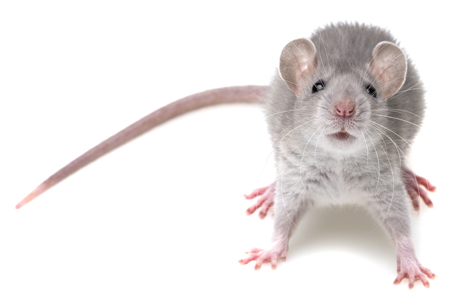HDAC Inhibitors Treat Mania-Like Symptoms in Mice
Mice with a particular genetic mutation affecting circadian rhythms exhibit symptoms that resemble those of human mania: disruption of sleep and wake cycles, hyperactivity, and reduced anxiety and depression. It has been found that these behaviors can be normalized by inhibiting a type of enzyme called histone deacetylases (HDACs). HDACs bring about epigenetic changes to gene transcription by removing acetyl groups from histones, the structures around which DNA is wrapped. Removal of the acetyl group tightens the structure of the DNA, making it more difficult to transcribe. The drug valproate (trade name Depakote) is one type of HDAC inhibitor. It prevents the removal of the acetyl groups, loosening the structure of the DNA, making it easier to transcribe.
A recent study by Ryan Logan and colleagues compared the effects of valproate and other HDAC inhibitors on mice with a mutation in the Clock delta 19 gene, which causes mania-like symptoms. Valproate and the HDAC inhibitor SAHA both normalized the mice behavior. MS275, another HDAC inhibitor that targets only class I HDACs, also normalized the behaviors. The researchers were able to determine that all of these treatments targeted a specific class I HDAC called HDAC2, which has been implicated in schizoaffective and bipolar disorders.
These data link epigenetic mechanisms (HDAC inhibition) to the antimanic effects of valproate in this animal model of mania. It appears that maintaining the presence of acetyl groups on histones has antimanic effects in mice with a mutation in the Clock delta 19 gene.
Exercise Helps Mice with Spacial Learning
Exercise increases brain-derived neurotrophic factor (BDNF), a protein that protects neurons and is important for learning and memory. In a study of mice who were trained to find objects, sedentary mice could not discriminate between familiar object locations and novel ones 24 hours after receiving weak training, while mice who had voluntarily taken part in exercise over a 3-week period could easily distinguish between these locations after the weak training.
Mice who received sodium butyrate (NaB) after training behaved similarly well to those who had exercised. Sodium butyrate is a histone deacetylase (HDAC) inhibitor, meaning it helps keep acetyl groups on histones, around which DNA is wrapped, making the DNA easier to transcribe. In this case the easy transcription of DNA enables learning under conditions in which it might not usually take place.
Both sodium butyrate and exercise promote learning through their effects on BDNF in the hippocampus. They make the DNA for BDNF easier to transcribe, suggesting that exercise can put the brain in a state of readiness to create new or more lasting memories.
HDAC Inhibitor Facilitates Extinction of Fear Memories in the Reconsolidation Window
Unwanted recall and re-experiencing of traumatic memories is thought to be a crucial mechanism leading to the onset of post-traumatic stress disorder (PTSD). The inability to diminish (extinguish) those memories contributes to the persistence of PTSD. A new study suggests that the extinction of fear memories can be enhanced by a drug that acts epigenetically to alter the structure of DNA and subsequent gene expression.
DNA is wound around structures called histones, and chemical changes can affect how loosely or tightly the DNA is wound. Johannes Graff et al. reported in the journal Cell in 2014 that application of a histone deacetylase (HDAC) inhibitor, which keeps acetyl groups on histones, ensuring that DNA is wrapped more loosely and is easier to activate (or transcribe), helps rodents revise both new and old fear memories after they have been actively recalled.
When a memory is actively recalled, the trace of that memory in the brain becomes more amenable to revision over the proceeding five minutes to one hour (a period known as the reconsolidation window). New learning and extinction training (to get rid of the memory) lasts much longer when it takes place during the reconsolidation window than when the same procedures are performed 6 hours later (after the reconsolidation window has closed) or if the procedures are performed in the absence of active recall of the memory (when the reconsolidation window is never opened).
We have previously described the 2013 work of Xue et al. published in the journal Science, which showed that this specific procedure could yield long-lasting extinction of a patient’s craving for cocaine or heroin, and could reduce amygdala activation (as observed via functional magnetic resonance imaging) in response to an experiment that produces conditioned fear (Agren et al. Science, 2013).
Editor’s Note: This new work by Graff et al. adds another twist. Older long-term memories are more stable and less amenable to new learning than more recent (but still long-term) memories. The application of an HDAC inhibitor changes this and makes even very old memories amenable to lasting revision. The HDAC inhibitor that Graff et al. used was a specific inhibitor for HDAC type II. However, the anticonvulsant valproate (Depakote) is a potent although nonspecific HDAC inhibitor, and presumably could have the same facilitating effect as the more selective drug.
EMDR (Eye Movement Desensitization and Reprocessing), which has been widely used for the treatment of PTSD, includes active memory recall, immediately followed by an attempt to re-interpret and construct new memories of the trauma. These elements could open the reconsolidation window. However, EMDR works less well with older memories compared to more recent traumatic memories.
The Graff et al. data would suggest that adding an HDAC inhibitor such as valproate to EMDR-like work might make it more effective in revising more remote memories. Graff et al. encourage controlled clinical trials with a type II inhibitor to confirm that their findings in rodents would generalize to humans. While awaiting such validation through controlled clinical trials, it would not be surprising if clinicians started trying out the paradigm on their own using valproate.




